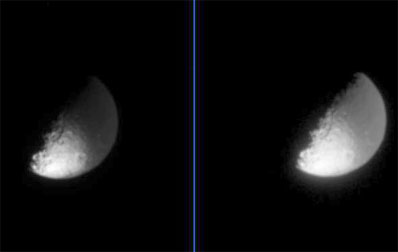CASSINI PHOTO RELEASE
Posted: August 22, 2004
The dark material that coats one hemisphere of Saturn's moon Iapetus is very dark, as these two processed views of the same image demonstrate.
 Credit: NASA/JPL/University of Arizona Download larger image version here |
The image was taken in visible light, with the Cassini spacecraft narrow angle camera from a distance of 2.9 million kilometers (1.8 million miles) from Iapetus, and at a Sun-Iapetus-spacecraft, or phase angle of 89 degrees. The image scale is 17 kilometers (11 miles) per pixel. The image has been magnified by a factor of four to aid visibility.
The Cassini-Huygens mission is a cooperative project of NASA, the European Space Agency and the Italian Space Agency. The Jet Propulsion Laboratory, a division of the California Institute of Technology in Pasadena, manages the Cassini-Huygens mission for NASA's Office of Space Science, Washington, D.C. The Cassini orbiter and its two onboard cameras, were designed, developed and assembled at JPL. The imaging team is based at the Space Science Institute, Boulder, Colo.
